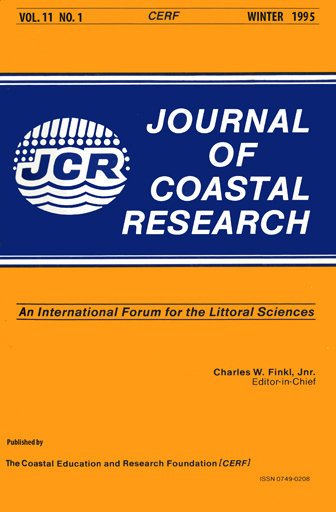Marine-Planation Terraces on the Shelf Around Grand Cayman: A Result of Stepped Holocene Sea-Level Rise
Keywords:
Coral reef, terrace, coastal cliff, marine erosion, sea level, continental shelf, submarine terrace, coastal erosion, spur-and-groove, ridge-and-furrowAbstract
The shelf around Grand Cayman consists of two seaward-sloping terraces separated by a mid-shelf scarp . Except along the exposed windward margin where coral growth is dominant, the upper terrace (0-10 m bal) largely consists of a barren rocky pavement traversed by erosional furrows. Exposure related trends in the morphology and distribution of these erosional features, and the lack of coral growth , demonstrates that the terrace is the result of contemporary erosion during seasonal storms . The upper terrace is terminated by a mid-shelf scarp (10-20 m bal) that, in most areas, is partially to completely buried by modern carbonate deposits . Along narrow sections of the leeward shelf, the scarp is commonly exposed and displays an erosional intertidal notch at - 18.5 m. The lower terrace (12-40 mbsl) extends from the mid-shelf scarp to the shelf edge. Its surface is a modern reef-and- sediment wedge that thickens toward the shelf edge, reaching up to 40 m in thickness. These deposits are underlain by a seaward-sloping bedrock terrace (20-40 m bal). This buried terrace and the mid-shelf scarp, which are geomorphic equivalents of the upper terrace and coastal cliff, represent an earlier episode of marine planation when sea level was stabilized at a lower position.
The contemporary erosional features of the upper -shelf terrace and the presence of identical terraces around recently uplifted islands demonstrates that the terraces on Grand Cayman were sculptured by marine erosion during the last deglacial sea-level rise. The lower terrace and the mid-shelf scarp were eroded during a slow-rise episode from 11- 7 ka and were subsequently drowned by an extremely rapid, 5 m rise-event at - 7 ka. Following this catastrophic event, which drowned fast -growing Acropora reefs in other areas of the Caribbean , sea-level stabilized and rose slowly to its present position , producing the upper terrace. This pronounced stepped pat tern in Holocene sea-level rise remains to be confirmed from outside the Caribbean-Atlantic reef province but is consistent with the stepped nature of pre-Holocene sea-level curves.
The presence of seaward sloping terraces on many shelves around the world suggests that erosional terrace cutting is a common phenomenon during sea-level rise. In contrast, terraces in areas that have undergone relative sea-level fall are constructional in origin, produced entirely by reef accretion. This suggests that there is a genetic relationship between the sea-level cycle and terrace type: erosional terraces form during rise and constructional terraces during fall.


